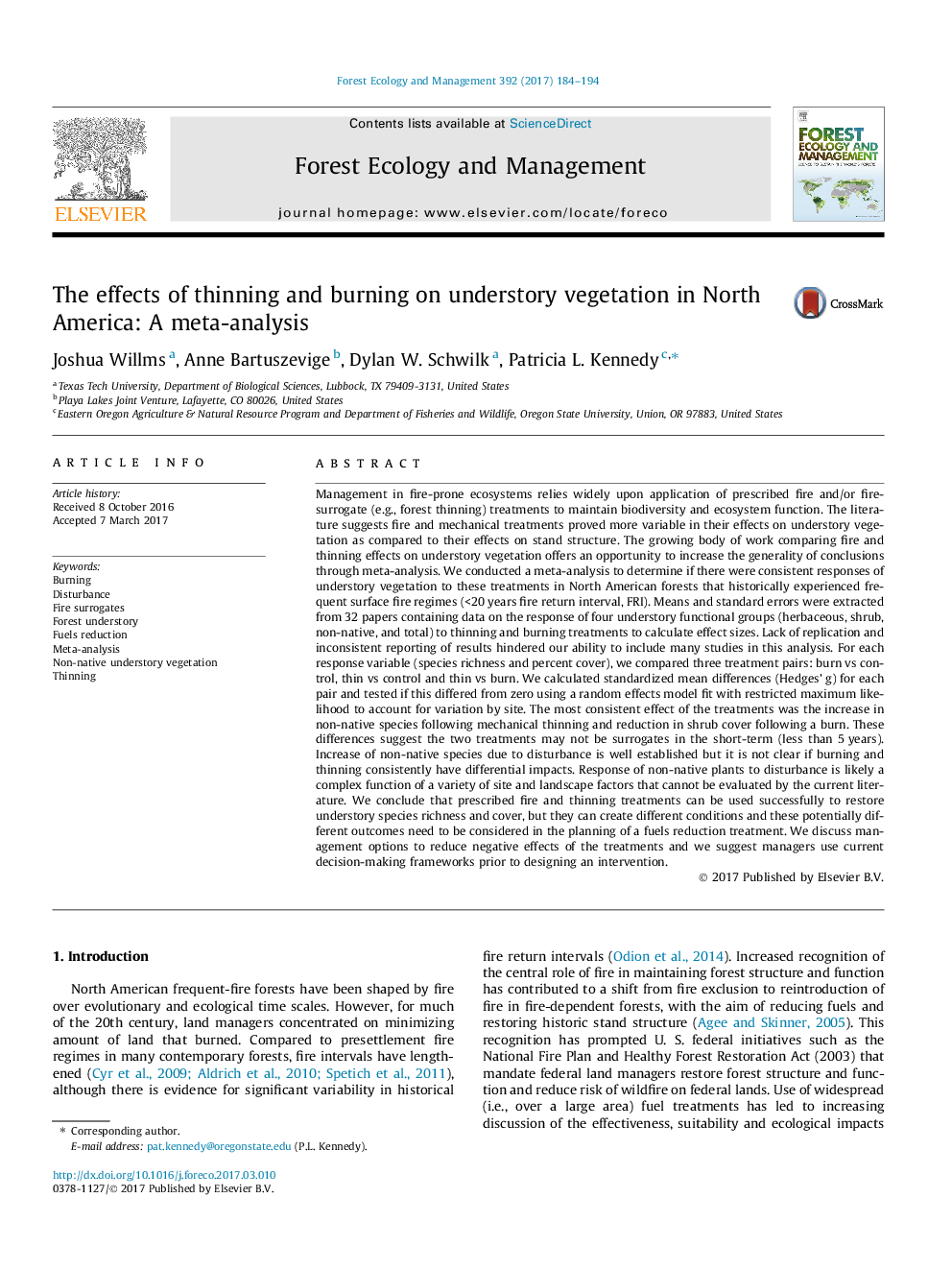| کد مقاله | کد نشریه | سال انتشار | مقاله انگلیسی | نسخه تمام متن |
|---|---|---|---|---|
| 4759477 | 1421366 | 2017 | 11 صفحه PDF | دانلود رایگان |
عنوان انگلیسی مقاله ISI
The effects of thinning and burning on understory vegetation in North America: A meta-analysis
ترجمه فارسی عنوان
اثرات نازک شدن و سوزاندن در پوشش گیاهی زیرزمینی در آمریکای شمالی: یک متاآنالیز
دانلود مقاله + سفارش ترجمه
دانلود مقاله ISI انگلیسی
رایگان برای ایرانیان
کلمات کلیدی
سوزش، اختلال، جایگزین های آتش، درخت جنگل، کاهش سوخت، متاآنالیز، پوشش گیاهی غیر بومی، تنزل
موضوعات مرتبط
علوم زیستی و بیوفناوری
علوم کشاورزی و بیولوژیک
بوم شناسی، تکامل، رفتار و سامانه شناسی
چکیده انگلیسی
Management in fire-prone ecosystems relies widely upon application of prescribed fire and/or fire-surrogate (e.g., forest thinning) treatments to maintain biodiversity and ecosystem function. The literature suggests fire and mechanical treatments proved more variable in their effects on understory vegetation as compared to their effects on stand structure. The growing body of work comparing fire and thinning effects on understory vegetation offers an opportunity to increase the generality of conclusions through meta-analysis. We conducted a meta-analysis to determine if there were consistent responses of understory vegetation to these treatments in North American forests that historically experienced frequent surface fire regimes (<20Â years fire return interval, FRI). Means and standard errors were extracted from 32 papers containing data on the response of four understory functional groups (herbaceous, shrub, non-native, and total) to thinning and burning treatments to calculate effect sizes. Lack of replication and inconsistent reporting of results hindered our ability to include many studies in this analysis. For each response variable (species richness and percent cover), we compared three treatment pairs: burn vs control, thin vs control and thin vs burn. We calculated standardized mean differences (Hedges' g) for each pair and tested if this differed from zero using a random effects model fit with restricted maximum likelihood to account for variation by site. The most consistent effect of the treatments was the increase in non-native species following mechanical thinning and reduction in shrub cover following a burn. These differences suggest the two treatments may not be surrogates in the short-term (less than 5Â years). Increase of non-native species due to disturbance is well established but it is not clear if burning and thinning consistently have differential impacts. Response of non-native plants to disturbance is likely a complex function of a variety of site and landscape factors that cannot be evaluated by the current literature. We conclude that prescribed fire and thinning treatments can be used successfully to restore understory species richness and cover, but they can create different conditions and these potentially different outcomes need to be considered in the planning of a fuels reduction treatment. We discuss management options to reduce negative effects of the treatments and we suggest managers use current decision-making frameworks prior to designing an intervention.
ناشر
Database: Elsevier - ScienceDirect (ساینس دایرکت)
Journal: Forest Ecology and Management - Volume 392, 15 May 2017, Pages 184-194
Journal: Forest Ecology and Management - Volume 392, 15 May 2017, Pages 184-194
نویسندگان
Joshua Willms, Anne Bartuszevige, Dylan W. Schwilk, Patricia L. Kennedy,
